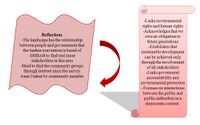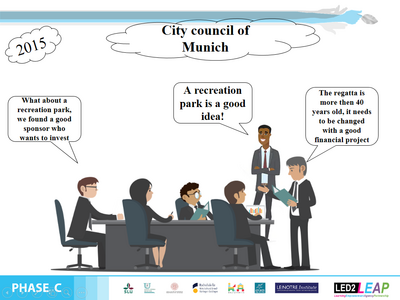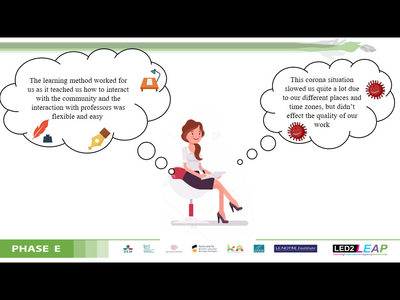LED2LEAP 2020 - Freising Team 9
>>>back to working groups overview
| Area | The Olympic rowing regatta course | |
| Place | Oberschleißheim, Munich | |
| Country | Germany | |
| Topics | Landscape Democracy | |
| Author(s) | Naida Kiso, Feryal Halimi, Oluwapelumi Adesoye, Simanta Dash | |

| ||
Landscape Democracy Rationale
- From a landscape democracy perspective, this community context is relevant because it's about a group of people coming together in the same place, to use beautiful landscape for the same interest, and that interest, is engaging in all kinds of sports and leisure activities. This community uses the same area of land to fulfill their human rights for engaging in sports activities.This is where we see the bridging of landscape and human rights which represent landscape democracy.
- This way of use of land is very beneficial for wellness and human health which also helps this landscape area to keep its sports spirit and character.
Location and scope
Phase A: Mapping your Community
Welcome to your community and its landscape
- The Olympic rowing regatta course is located six kilometres north of the Olympic Park, half on Munich soil, half on Oberschleißheim soil, in the Dachauer Moos and covers an area of 850,000 square metres.
- Historical place
- The Olympic Games competition venue
- It represents a piece of post-war heritage
- The facility needs renovation
Groups of actors and stakeholders in your community
- Main Actor groups: Olympic Park, Authority, Clubs/stakeholders, Athletes
- Sub-actor groups: Employee, Visitors, Recreationists
- More Visible groups: athletes
- Less visible groups: visitors
- Do to this Corona situation, we don’t know opinions of local people and all our work is based on assumptions and research through internet.
Relationships between your actors and groups
- Main actor groups are larger groups and they are in power over the smaller sub-actor groups
- add 1-2 graphical representations to the image gallery based on your PPT presentation, you can add more if you like
Summary of your learnings from the transnational discussion panel on April 22
On April 22 you will present the PPT version of this first assignment to other seminar groups working in other geographical community contexts. Please give here a short summary of your learnings during this presentation, for example:
- Other analytical approaches
- Other representation styles
- Other value schemes: any surprises?
- Constructive comments we received on our presentation
Theory reflection
- Stories of Collective Capital is useful to gather and sense the community characteristics and create a foundation for future positive changes.
- The landscape has the relationship between people and governments that the Aarhus convention is based of
- Links environmental rights and human rights
- Acknowledges that we owe an obligation to future generations
- Establishes that sustainable development can be achieved only through the involvement of all stakeholders
- Links government accountability and environmental protection
- Focuses on interactions between the public and public authorities in a democratic context.
References
- Site: https://www.unece.org/info/ece-homepage.html
- Site: file:///C:/Users/PC/Desktop/Kuehne_Antrop_LandscapeConcepts.pdf
- Site: https://regatta.bayern/en/olympic-regatta-center/
- Site: https://www.openpetition.de/petition/online/munich-oberschleissheim-save-the-regatta
- Site: https://www.leistungszentrum-muenchen.de/en/
Phase B: Democratic Landscape Analysis and Assessment
The Scene in your Story of Analysis
- Our challenge; This project is premised on the frequent clashes that occur between the different demography of people who utilize the Olympic Rowing Regatta Course facilities; with emphasis on the sweet-sour relationship between professional athletes and recreationists. This problem is largely due to the multifarious activities happening concurrently on the project site as well as its extensive footprint.
- The Olympic Rowing Regatta Course is a purpose-built sporting facility designated as the venue for Rowing and Canoeing events of the 1972 Summer Olympics. It is located approximately 6km north of the Olympic park and covers an area of about 850,000 square metres. The implication of this sprawling area is that the centre sits partly on Munich soil as well as in Oberschleif3heim, Dachauer Moos. This immense post-war heritage features a 2.23km long, 140m wide and 3.5m deep artificial Regatta Course, asphalt tracks for cycling, tennis courts, volleyball etc. It also has a network of ancillary facilities, including, gymnasiums, restaurants, conveniences, accommodation, campground etc. The idyllic development is surrounded by an eclectic land-use ranging from agricultural farmlands, grazing pastures and protected forests to other more "urban" typologies.
The Actors in your Story of Analysis
- Main actors in the story are internal stakeholders who have the most profound impact on the project and play significant roles in the administration of the facility.
They include: Government and other regulatory agencies Olympic Park Authority - Stakeholders - Sponsors Athletes
- SUB-ACTORS
Also playing significant roles, albeit on a much smaller scale, the sub-actors are stakeholders who are affected by the outcomes of the main players. They include: Employees - Volunteers Recreationists Tourists
The Story of Analysis
- Our story revolves around a recreationist named Hanz.
Hanz likes spending his weekends in the regatta course of Munich, to enjoy the magnificent scenery there and practice his favorable hobbies, cycling and jogging that helps him to relax from the long working week. but Hanz finds some difficulties in practicing what he loves freely around the regatta as he often gets into some conflicts with the professional athletes practicing in the same area as they find recreationsts a bothering for their activities.
- How can Hanz practice in the regatta course without having any conflicts with anyone? without bothering the athletes or other recreationists?
Reflect on your Story of Analysis
- IN DEVELOPING AN ALL-INCLUSIVE, WORKABLE DESIGN SCHEME, IT IS IMPORTANT TO IDENTIFY THE PROJECT STAKEHOLDERS ARE AT ALL LEVELS; THIS WILL BE INVALUABLE GUIDE IN THE DESIGN PROCESS AS THEIR PARTICIPATION WILL ENSURE THAT COMMUNAL EXPECTATIONS ARE MET UPON COMPLETING THE PROJECT.
- THE BUFFET METHOD IS IDENTIFIED AS AN APPROPRIATE DESIGN APPROACH IN THE DIVERSE MUNICH-OBERSCHLEIgHEIM COMMUNITY. THE VARIOUS STAKEHOLDERS COME FROM DIFFERENT WALKS OF LIFE, HAVE DIFFERENT VIEWS AND OPINIONS WHICH INVARIABLY SHAPE THEIR RESPECTIVE EXPECTATIONS. THIS METHOD HELPS BRING EVERYONE TOGETHER WITHOUT ANY BIAS AND ENGAGES THEM IN A PRODUCTIVE ENDEAVOUR THAT WILL HELP SHAPE THEIR COMMUNITY.
- ALL CONVERSATIONS AT THE BUFFET PLUS THE DESIGN OUTCOMES POSITED BY THE DIFFERENT COMMUNITY MEMBERS (BASED ON THEIR INDIVIDUAL EXPERIENCES AND LEVELS OF EXPOSURE) WILL HELP GUIDE THE DESIGN PROFESSIONALS DURING THE DESIGN AND PROJECT IMPLEMENTATION PHASES, ENSURING THAT A FULLY FUNCTIONAL,
Phase C: Collaborative Visioning and Goal Setting
The Scene in your Story of Visioning
The challenge in our story is the conflict happening between the different users of the regatta course, based on some reviews of the visitors online and few survey answers from the regatta workers, we could conduct our landscape democracy challenge, since the corona situation prevented us from going personally on site we had to do our research electronically.
The Actors in your Story of Visioning
Main actors:
Sponsors: are the main financial source for most of the athletes, clubs and associations that use the regatta center
Athletes: Are the main users of the regatta, after all the center was originally build for the 1972 olympic rowing games
sub actors:
Recreationists - Tourists and Visitors who use the regatta for relaxation time by using the different activities that the center offer, or enjoying their hobbies like cycling and jogging, they are an important income source for the surrounding hotels and leisure centers
Regatta staff: are the regatta management who are responsible for the organisation and implementation of the different events held on the center
The Story of Visioning
The next story explains our goals, vision and our action plan and how we obtained them;
Scene 1; In 2015 Munich's city council decided to change the regatta's olympic character and build a recreational park instead
Scene 2; In 2016 the regatta's stakeholders started acting to save the regatta by creating a petition to be delivered to Munich's city council, they collected more than 16000 signatures. Te delegation was consisted of Johan who represents the rowing teams and the different associations and Anna, a canoeist who's father was a golden medal winner in the 1972 olympic games and who is a regatta worker
Scene 3; In 2019 the city council decided to keep regatta's Olympic character and start a renovation plan
Scene 4; Leopold who is from the city council contacts Ellen one of the regatta's staff to organize an event that will have all the stakeholders together in one place, Ellen suggests a festival.
Scene 5 Ellen meets with her coworkers and start organizing and planning the event
Scene 6 Ellen explains the plan
Scene 7 The different stakeholders meet together to discuss the feedback from the festival and a resolution was reached after a long discussion
Scene 8 Ellen explains the next step after the festival
Scene 9; Vision and action plan
the most important points when formulating our goals are;
- Environmentally responsible; Respect the environment and help to get it better
- Socially responsible; Respect and integrate with every social group of the community
- Dynamism; It is important to be characterized with serious actions and activity
- Aesthetic; Beauty is a very important element of any designer's work
Phase D: Collaborative Design, Transformation and Planning
Your Prototyping Action
The aim of this intervention is to create an environment where the different demography of users, that we previously identified, can make use of the regatta facility without clashes. So any design element we add, anything we propose is going towards solving an existing problem.
This intervention signifies that design can be an equalizer in a community and that it can actually solve the problems in our area. By proposing this intervention in the project area we want people, from different demography, to actually enjoy the facilities without any bias.
The Evolution of Your Prototyping Action
All the stakeholders contributed to achieve this action, athletes, sponsors, re-creationists and the different community members.
everyone should feel like they are part of the community without any prejudice.
Dialogue is a key in any community. Every community member should have a voice and contribute in problem solving if the challenges arise.
The Plan Behind Your Prototyping Action
1) The design team working together:
- Researching and finding the problems.
- Brainstorming the solutions.
2) Preparing the surveys and interviews:
-starting the observation phase by collecting feedback from the stakeholders
3) Community engagement:
- Design team is going back to the drawing board and putting together design elements, based on community feedback, which will be brought to the next phase.
4) Buffet stage and prototype presentation:
- Using the Buffet method as a tool to collect the different views and opinions of the chosen community members ( few persons from every stakeholders category) about the future of the regatta course
- Design solution/prototype is brought to the table and the presented, so that the members of the community can give a feedback.
5) Implementation phase: where we apply our prototype on the field
The Realization of Your Prototyping Action
We wrote to the regatta administration and sponsors:
Told them about our idea of realizing these events and let them know what do we need from them in order for it to happen
Sent them samples of our questionnaires
Prepared consent letters which are going to be handed out to people while taking part in questionnaires...
We needed the presence of all the stakeholders in order to achieve our goals;
Athletes - Sponsors - Recreationists - community members - Tourists - Regatta management
Reflect on Your Prototyping Action
Our action helped to end the clashes that used to occur between the regatta's users especiallybetween the athletes and the different recreationists
We could conduct our success indicators which are:
- Good planning
- Using the right materials
- Staying in budget limits
- Do our best by presenting a good performance
- Getting the maximum positive feedback as possible
- Reaching the achievement of our goals and vision
After our intervention using the created prototype, we could conclude that;
This prototype is a low fidelity one
The prototype needs more testing
It can be evoluted by the right experts
Phase E: Collaborative Evaluation and Future Agendas
Collaborative Evaluation and Landscape Democracy Reflection
Our challenge remained the same during this course which is resolving the conflicts between the different regatta users
The proposed solution to solve this challenge was relevant to some of the UN sustainable development goals which are: 11) Sustainable cities and communities 3) Good health and well being 10) Reduced inequalities 15) Life on land
Our work with the community contributed to the SDG's and didn't modifie them by:
- Proposing solutions to end the challenge
- Aiming to equal rights to use the facility and eliminate any discrimination between the community members
- Promoting good health and physical activities
- Aiming to a sustainable management of the regatta in the future
- A sustainable future for the regatta course and its community
The Actors in your Collaborative Evaluation
The power structure of the regatta's community belongs to people who make decisions on top since they are the ones who control (like Munich's city council), but once a community band together and unifies its voice can make change, like the regatta's community members achieved to save it from loosing its Olympic and sport character.
As design professionals, we are satisfied with the role we've played in this project. The challenge has afforded us the opportunity to put our problem-solving skills to use while working on a multidisciplinary team
Reflection of the Online Seminar
This corona situation prevented us from engaging the community and understand it better personally.
The theoretical material helped us to understand our actions better and put us on the right truck. The assignments allowed us to comprehend how to engage a community through out the different course phases. Getting information online was pretty difficult since nobody accepted to answer our survey except few regatta workers there for it was a bit challenging to address the landscape democracy challenge with the right action plan.
Reflection of the Living Lab Process
The COVID-19 situation affected our living lab activities, since it prevented us from gathering the necessary data for our work and visiting our site in person. therefore we were obliged to build our action plan on assumptions.
- add the corresponding visual from your presentation to the image gallery below
Your Living Lab Code of Conduct
The main values that drove our living lab are: Honesty - Communication and Respect
ُevery member has these values which made working together much easier and fluent
Process Reflection
This living lab group did its best to achieve the goals and vision concluded during this course, even though the team members are scattered in three countries with different time zones and different life attachments, and although this course is lot further from our study fields we were able to finish the assignments. This course enhanced our design thinking and imagination by completing the different phases and listening to a multicultural group of lecturers who had an insightful perspective and stories.
Our understanding for the assignments and lectures all along this course has progressed significantly as you can notice (from our perspective) from phase A to phase E, although it wasn’t easy to keep up with our packed study schedules and all the other assignments and online classes, we were able to make it and finish every assignment on time.
This course helped our team to understand each other and communicate better, we learnt the group work by respecting and giving every member a voice.As it teached us which methods and necessary tools to use to understand and engage a community and reaching its stakeholders.
The CORONA pandemic limited our research and actions as all the work have been done based on online informations and assumptions, in the future we would love to implement our action plan on site with real community members.










































